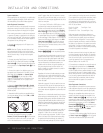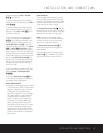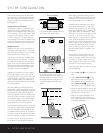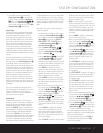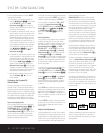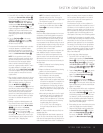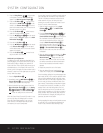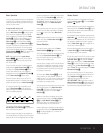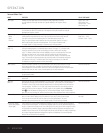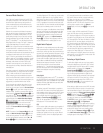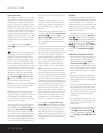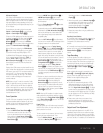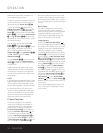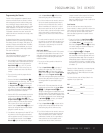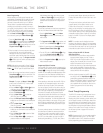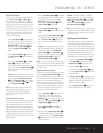
22 OPERATION
OPERATION
MODE FEATURES DELAY TIME RANGE
Dolby Digital Available only with digital input sources encoded with Dolby Digital data. It provides Center: 0ms – 5ms
up to five separate main audio channels and a special dedicated Low-Frequency Effects Initial Setting: 0ms
channel. Surround: 0ms –15ms
Initial Setting: 0ms
DTS Available only with digital input sources encoded with DTS data.Available on special DVD, Delay time not adjustable
LD and audio-only discs, DTS provides up to five separate main audio channels and a special
dedicated low-frequency channel.
Dolby Pro Logic II Dolby Pro Logic II is the latest version of Dolby Laboratory’s benchmark surround technology Movies: 10ms – 25ms
Movies that decodes full-range, discrete left, center, right, right surround and left surround channels Music: 0ms – 15ms
Music from either matrix surround-encoded programs or conventional stereo sources. The Emulation: 10ms – 25ms
Emulation Dolby Pro Logic II Movies mode is optimized for movie soundtracks, while the Pro Logic II
Music mode should be used with musical selections. The Pro Logic II Emulation mode
re-creates original Pro Logic processing for those who prefer that presentation.
Logic 7 C Logic 7 is an advanced mode that extracts the maximum surround information from either Delay time not adjustable
Logic 7 M surround-encoded programs or conventional stereo material. The Logic 7 C, or Cinema, mode
should be used with any source that contains Dolby Surround or similar matrix encoding.
Logic 7 C delivers increased center-channel intelligibility, and more accurate placement of sounds
with fades and pans that are much smoother and more realistic than with other decoding
techniques. The Logic 7 M, or Music, mode should be used with analog or PCM stereo sources.
Logic 7 M enhances the listening experience by presenting a wider front soundstage and greater
rear ambience. Both Logic 7 modes also direct low-frequency information to the subwoofer
(if installed and configured) to deliver maximum bass impact.
Dolby 3 Stereo Uses the information contained in a surround-encoded or two-channel stereo program to create No surround channels
center-channel information. In addition, the information that is normally sent to the rear-channel
surround speakers is carefully mixed in with the front-left and front-right channels for increased realism.
Use this mode when you have a center channel speaker but no surround speakers.
Theater The Theater mode creates a sound field that resembles the acoustic feeling of a standard Delay time not adjustable
live performance theater.
Hall 1 The two Hall modes create sound fields that resemble a small (Hall1) or medium-sized (Hall 2) Delay time not adjustable
Hall 2 concert hall.
VMAx Near When only the two front-channel loudspeakers are used, Harman’s patented VMAx mode delivers a three- No surround channels
VMAx Far dimensional sound space with the illusion of “phantom speakers” at the center and surround positions.
The VMAx N, or Near Field, mode should be selected when your listening position is less than five feet
from the speakers. The VMAx F, or Far Field, mode should be selected when your listening position is
greater than five feet from the speakers. The VMAx modes are also available using the Headphone
Jack 4. When headphones are being used, the Far Field mode will appear to push the sound field
away from your ears, reducing the “inside the head” sensation often experienced when using headphones.
5-Channel Stereo This mode takes advantage of multiple speakers to place a stereo signal at both the front and No delay is available for
back of a room. Ideal for playing music in situations such as a party, it places the same signal this mode
at the front-left and surround-left, and front-right and surround-right speakers. The center
channel is fed a summed mono mix of the in-phase material of the left and right channels.
Surround Off (Stereo) These modes turn off all surround processing and present the pure left- and right-channel presentation No surround channels
Stereo-Direct
(Bypass)
of two-channel stereo programs. The Stereo-Direct (Bypass) mode may only be used with analog source
Stereo-Digital inputs, as it preserves the analog format of the audio signal for its entire path of travel through the receiver
to the speaker and subwoofer outputs, bypassing all digital processing. Digital bass management is not
available in Stereo-Direct mode. The Stereo-Digital mode can be used with either an analog or digital input,
as the signal undergoes digital bass management to optimize the distribution of the low frequencies
between the main speakers and a subwoofer.
Surround Mode Chart



